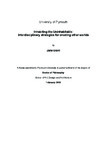Inhabiting the Uninhabitable: Interdisciplinary strategies for creating other worlds
| dc.contributor.supervisor | Phillips, Mike | |
| dc.contributor.author | Grant, Jane | |
| dc.contributor.other | School of Art, Design and Architecture | en_US |
| dc.date.accessioned | 2018-06-11T14:56:37Z | |
| dc.date.issued | 2018 | |
| dc.identifier | 10617849 | en_US |
| dc.identifier.uri | http://hdl.handle.net/10026.1/11641 | |
| dc.description.abstract |
This thesis for PhD by Publication presents artworks and writing that propose and create ‘other worlds’. Many of the artworks and writing engage scientific concepts, both historical and contemporary, however it is the phenomenological aspects of these ideas that are engaged. The research mostly deals with the infinitesimal and the distant, neuroscience, astrophysics and sometimes both. It also deals with boundaries as porous and indefinite thresholds, a reoccurring concept in my research. The artworks are mainly participatory as it is my aim to develop a strategy for ‘inhabitation’. I introduce three forms of intuition as methodologies with which to engage with phenomena outside of our human sensorium. They are as follows: Firstly, structural intuition by means of Martin Kemp, a sensory and haptic understanding of the world that affords insights into more abstract or elusive materials or ways of being. Secondly, intuition as method by means of Henri Bergson, a form of ‘looking from within’ that attempts to engage the with beings or phenomena that lie outside of our sensory system and abstract or intellectual domain. I expand on Bergon’s method via Gilles Delueze’s heterogeneous field and Elizabeth Grosz’s further development of this method. And thirdly I also include panpsychism as a form of ‘being with’ the non-human or phenomenon by means of William James, David Chalmers, Karen Barad and Christof Koch. This is not to prove panpsychism as a reality but to understand it as a tool to build a bridge between human and other beings, things, atmospheres with which we share our world and beyond. In the conclusion I briefly address the ‘non-human turn’ as an expansion of our understanding of sentience in things, beings and atmospheres. I have proposed these forms of intuition to draw attention to the methodologies I use when working with ideas that lie outside of my expertise. These methods also apply to research that does not have scientific origins. These methods form a framework for process and production of artworks when engaging with the abstract, invisible or elusive. The main body of the research in this PhD by publication is presented in the forms of artworks and articles. The artworks The Fragmented Orchestra (Grant, Matthias, 6 Ryan, 2008), Ghost (Grant, 2011) and Plasticity (Grant, Matthias, Kin, Ryan, 2011) have at their core research on models of firing neurons with particular reference to Eugene Izhikevich’s work on spike timing dependent plasticity. I also draw from Henri Bergson’s work on memory and Gilles Deleuze’s work on fields. Other research presented includes artworks and papers relating more to astrophysical concepts at their core are Soft Moon, (Grant. 2010), Soft Moon: Exploring Matter and Mutability in Narratives and Histories of the Earth-Moon System, (Grant, 2013) Fathom, (Grant, Matthias, 2013) and newer works. These works reference Bergson once more, the physicist Lee Smolin, writer Italo Calvino and Stanislaw Lem, and others. Here I integrate art, science, science-fiction, and philosophy alongside the writing of architect Juhani Pallasmaa. This document describes my aim to inhabit other worlds (often from the histories of science) by engaging overlapping methodologies of intuition and practice in which I attempt to engage directly with the abstract, the unfathomable, the distant, or the miniscule. I have developed this strategy to allow me to create artworks and writing that externalize these aims and that allow others, participants and readers, to encounter and engage in these other worlds too. This interdisciplinary and rhizomatic strategy synthesizes ideas into new forms with which we can inhabit the uninhabitable. | en_US |
| dc.language.iso | en | |
| dc.publisher | University of Plymouth | |
| dc.rights | Attribution-NonCommercial-NoDerivs 3.0 United States | * |
| dc.rights.uri | http://creativecommons.org/licenses/by-nc-nd/3.0/us/ | * |
| dc.subject | Art Practice | en_US |
| dc.subject | Science | |
| dc.subject | Intuition as Method | |
| dc.subject | Bergson | |
| dc.subject | Barad | |
| dc.subject | Attunement | |
| dc.subject | The Fragmented Orchestra | |
| dc.subject.classification | PhD | en_US |
| dc.title | Inhabiting the Uninhabitable: Interdisciplinary strategies for creating other worlds | en_US |
| dc.type | Thesis | |
| plymouth.version | publishable | en_US |
| dc.identifier.doi | http://dx.doi.org/10.24382/910 | |
| dc.identifier.doi | http://dx.doi.org/10.24382/910 | |
| dc.rights.embargodate | 05/07/2019 | |
| dc.rights.embargoperiod | Extended | en_US |
| dc.type.qualification | Doctorate | en_US |
| rioxxterms.version | NA | |
| plymouth.orcid.id | 0000-0003927-9750 | en_US |
Files in this item
This item appears in the following Collection(s)
-
01 Research Theses Main Collection
Research Theses Main



